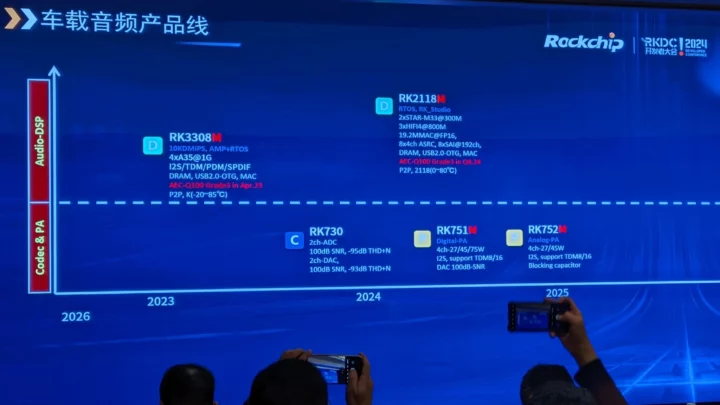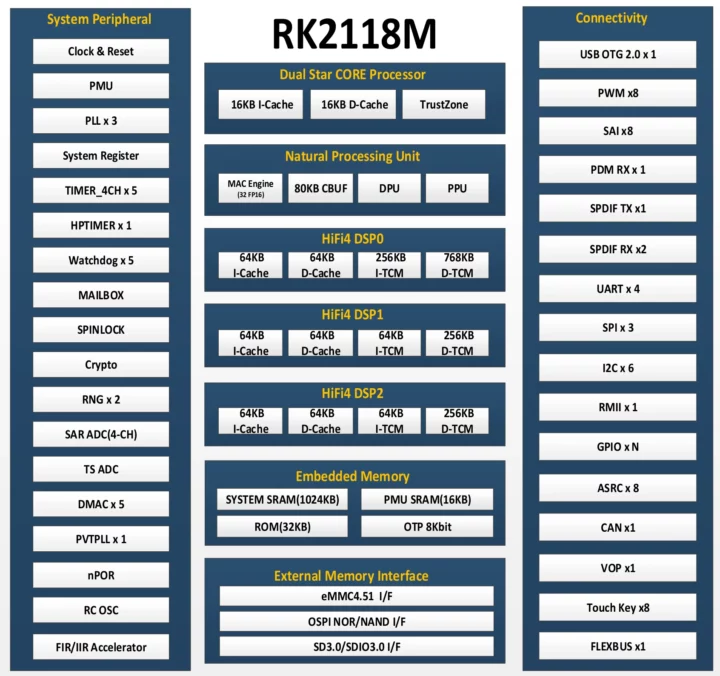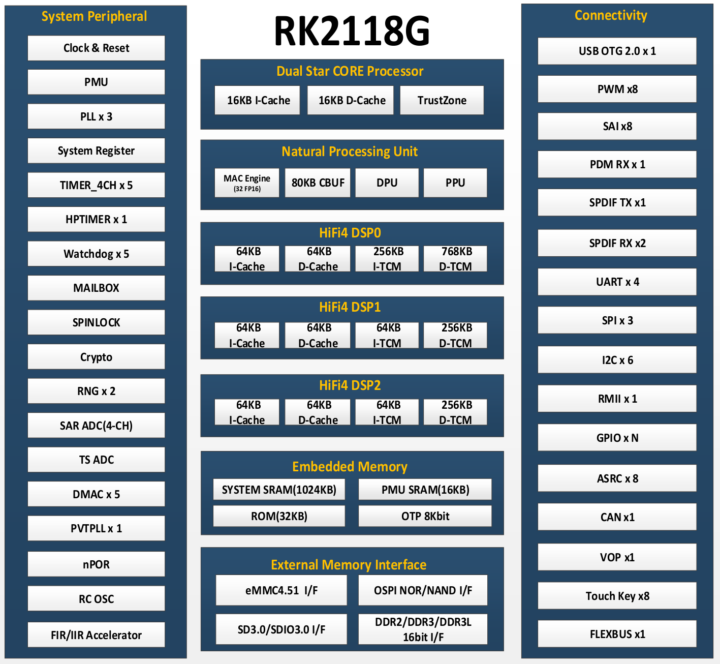Rockchip RK2118G and RK2118M smart audio microcontrollers based on a dual-core Star-SE Armv8-M processor, an NPU for smart AI audio processor, three DSPs, 1024KB SRAM, optional DDR memory in package, and a range of peripherals.
I first noticed the RK2118M in slides from the Rockchip Developer Conference 2024 last March, but I did not have enough information for an article at the time. Things have now changed since I’ve just received a bunch of datasheets including the one for the RK2118G and RK2118G microcontrollers, which look identical except for the DDR interface and optional built-in 64MB RAM for the RK2118G.

The datasheets have only one reference to Arm with the string “Arm-V8M” and nothing else, and Cortex is not mentioned at all. But the slide above reveals the STAR-SE core looks to be an Arm Cortex-M33 core. We also learn the top frequencies for the “STAR-M33″/”STAR-SE” core (300MHz) and the DSPs (800MHz) neither are listed in the datasheet. The “STAR-SE” comes from Arm China, and while I could not find any detailed information about it, it’s also mentioned on Arm’s developer website for a vulnerability that also impacts Cortex-M33/M35/M55 cores which implies Arm is fine with it.
Rockchip RK2118G and RK2118M specifications:
- CPU – Dual-core Star-SE (Cortex-M33) processor @ 300 MHzbased on Armv8M architecture with Thumb-2 support, FPU, MPU, Arm TrustZone, 16KB I-Cache and 16KB D-Cache
- DSP – Tri-core HiFi4 DSP processor @ 800 MHz
- DSP0 – 256KB ITCM, 768KB DTCM, 64KB I-Cache, 64KB D-Cache
- DSP1, DSP2 -64KB ITCM, 256KB DTCM, 64KB I-Cache, 64KB D-Cache
- Neural Process Unit – 32x float point 16-bit MAC operations per cycle, 80KB internal buffer; supports TensorFlow, Caffe, Tflite, Pytorch, Onnx NN, Android NN, etc.
- FIR/IIR Accelerator
- Internal memory and storage
- BootROM
- 1024KB System SRAM
- 16KB PMU SRAM
- Optional integrated DDR memory, for example, 512 Mbit (64MB) DDR in RK2118G only
- External memory and storage
- 16-bit DDR2/DDR3/DDR3L up to 1024MB (RK2118G only)
- SPI NOR/NAND flash
- eMMC 4.51 flash
- SD Card (SD 3.0, MMC ver 4.51, SDIO 3.0 protocol)
- Display Interface
- RGB888/RGB565 source data format
- RGB888/RGB565/RGB666 display data format
- i8080 MCU serial interface up to 480×480 resolution
- Audio
- 8x SAI components (I2S, PCM, TDM)
- 5-wire PDM interface for up to 8x mono microphones with 16 to 24-bit sample resolution
- SPDIF – 1x Tx, 2x Rx
- 8x ASRC components (Asynchronous Sample Rate Converter)
- Networking – 10/100M Ethernet Controller
- USB – USB 2.0 OTG port up to 480 Mbps
- Other peripherals
- Multiple groups of GPIOs
- 4x UART
- 6x I2C interfaces
- 3x SPI controllers (SPI0: serial-slave; SPI1/2: seria-master+serial-slave)
- 8-channels PWM with interrupt-based operation
- 1x CAN Bus with CAN 2.0B protocol support
- Multi-channel touch key controller
- FLEXBUS interface
- Support transfer data from internal memory to GPIO by DMA
- Support transfer data from GPIO to internal memory by DMA
- Analog
- 10-bit SARADC with 1MB/s sampling rate
- Temperature sensor (-40 to 125°C range)
- 5x embedded DMA controllers
- Timers
- 20x 64-bit timers with interrupt-based operation
- 1x 64-bit timer for low-power mode application
- Watchdog
- Security
- Cipher engine
- Support SHA-1, SHA-256/224, MD5 with hardware padding
- Support HMAC of SHA-1, SHA-256, MD5 with hardware padding
- Support AES-128, AES-192, AES-256 encrypt & decrypt cipher
- Support AES ECB/CBC/OFB/CFB/CTR/CTS/XTS/CCM/GCM/CBC-MAC/CMAC mode
- Support up to 4096 bits PKA mathematical operations for RSA
- 2x 256 bits RNG output
- Secure boot, secure debug, secure OTP (8K bits size), secure OS, bus firewall
- Cipher engine
- Package
- RK2118G – QFP128L (14 x 14mm; lead pitch: 0.4mm)
- RK2118M – QFP128L (14 x 14mm; lead pitch: 0.4mm)
- Temperature Range (Tj) – -40 to +125°C (in RK2118G datasheet, shown as TBD in RK2118M datasheet, and 0 to 80 for RK2118 in the slide above…)
- Certifications – AEQ-100 Grade 3 expected in Q4 2024

As one would expect, there’s nothing about software in the datasheet, but the slide lists an unnamed RTOS and RK_Studio support. It’s unclear what the latter is, but I would suspect it might be an IDE developed by Rockchip. I could also find the RK2118 mentioned in the same rknn-toolkit2 framework used by AI SoCs from the company such as RK3568 or RK3588.
It’s not Rockchip’s first venture into microcontrollers, but the company has not exactly been successful in this specific market in the past, as for instance, the Rockchip RKi6000 low-power WiFi microcontroller does not seem to have even come to market, and I’ve seldom seen the company’s RKNano microcontrollers in products or boards. We’ll see how it goes with the new RK2118 series.

Jean-Luc started CNX Software in 2010 as a part-time endeavor, before quitting his job as a software engineering manager, and starting to write daily news, and reviews full time later in 2011.
Support CNX Software! Donate via cryptocurrencies, become a Patron on Patreon, or purchase goods on Amazon or Aliexpress






Looks mixed up with the optional DDR
Who knows, maybe there will be a SKU for full 4Gbit package in the future?
Then again, RK3308G was only 64MB.
I wonder why they decided to go with 3xHiFi 4. That kind of sheer DSP power outclasses even desktop SoCs.
As an example, Intel Alder Lake has 4x HiFi 3 @ 400 MHz(maximum freq).
AMD Rembrandt(probably Van Gogh/Steam Deck and newer ones too) has one HiFi 5 @ 800 MHz(maximum freq). But they had a single HiFi 3 @ 600 MHz with Renoir.
So that is a ton of processing power for Audio and they even include a FIR/IIR accelerator too. I would think that the idea would be to perform some filters in that accelerator.
Spatial audio output? Depending on the number of output channels you might need more than one DSP.
Spatial Audio is generally with 2 output channels(i.e. stereo), isn’t it?
It should be rather computationally expensive but I don’t know if it’s true for new ones like the HiFi 4 which can do a lot more than the older HiFi 3 or HiFi 2, their SIMD capability should be very good.
There is also the IIR/FIR accelerator for those transfer functions.
Though I have no experience with audio things, was just really surprised since it seems like a very powerful solution. Specially as most of audio coprocessing power in PCs and consumer devices seem to go pretty much unutilized.
Spatial audio works on as many channels as you want. My home theater does it on 14 channels. Each of those 14 channels has to be computed independently since the speakers are all in different places.
And also a separate npu with 64MB RAM! This really seems like a BEAST. Not sure how to utilize all co-processors and DSPs without running Linux, tbh
I don’t mind and you shouldn’t, apparently multitasking on these is a matter of large context switches, so having multiple instances could also mean working in parallel on different sound streams or algorithms altogether.
I already have found first listings for RK2118G EVB, hope the chip itself gets widely available in “the west” despite the Arm China situation.